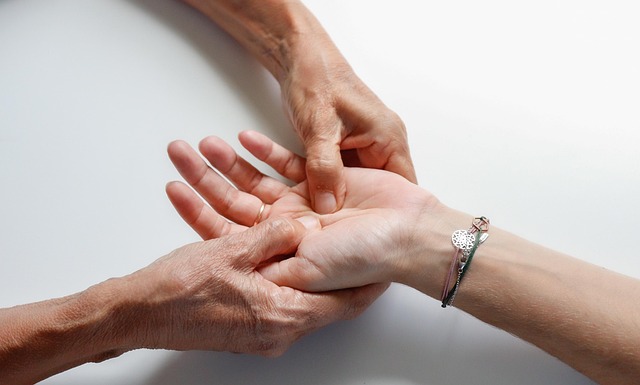Panic attacks, driven by unknown triggers and characterized by intense fear, are manageable through anxiety treatment. CBT, a proven method, focuses on changing negative thought patterns and identifying triggers. Breathwork and relaxation techniques offer natural remedies, while medications like SSRIs and benzodiazepines provide relief. Lifestyle changes, including exercise and mindfulness, are key to long-term management. Support groups and therapy enhance coping mechanisms. Holistic approaches like meditation, yoga, and herbal remedies also show effectiveness in treating anxiety disorders.
Panic attacks can be debilitating, but there are effective strategies for managing and overcoming them. This comprehensive guide explores various treatments for anxiety, from understanding panic attack symptoms and triggers to proven therapeutic approaches like Cognitive Behavioral Therapy (CBT). We delve into breathwork, relaxation techniques, medication options, lifestyle changes, support groups, and alternative holistic remedies. Discover how these methods can empower you in your journey towards long-term recovery from anxiety disorders.
Understanding Panic Attacks: Symptoms and Triggers

Panic attacks are intense periods of fear or discomfort that can come on suddenly, often with no apparent cause. Symptoms can include a racing heart, sweating, trembling, shortness of breath, and feelings of impending doom. These episodes can be extremely distressing, but it’s important to understand they’re not dangerous and can be managed effectively.
Several factors can trigger panic attacks, including stress, anxiety, certain medications, or even physical health conditions. Identifying personal triggers is a crucial step in anxiety treatment. Once recognized, individuals can develop strategies to avoid or cope with these triggers, helping to reduce the frequency and intensity of panic attacks.
Cognitive Behavioral Therapy: A Proven Approach

Cognitive Behavioral Therapy (CBT) is a well-established and effective approach for managing panic attacks and related anxiety disorders. This therapeutic method focuses on identifying and changing negative thought patterns that contribute to fear and anxiety. By challenging and modifying these unhelpful thoughts, CBT helps individuals gain control over their emotional responses during panic episodes.
During CBT sessions, patients learn to recognize triggers and understand the connection between thoughts, feelings, and behaviors. They acquire coping strategies to manage anxiety symptoms, such as deep breathing exercises and relaxation techniques. The goal is to replace irrational fears with realistic perspectives, thereby reducing the frequency and intensity of panic attacks over time. CBT offers a structured framework that empowers individuals to take control of their mental health and lead more fulfilling lives.
Breathwork and Relaxation Techniques for Control

Breathwork and relaxation techniques are powerful tools in the arsenal against panic attacks, offering a natural and effective way to manage anxiety. Slow, deep breathing activates the parasympathetic nervous system, promoting relaxation and calming the mind. This simple yet profound practice can help individuals regain control during a panic attack, reducing symptoms like rapid heartbeat and dizziness.
By focusing on steady, controlled breaths, individuals can disrupt the cycle of fear and panic. Techniques such as diaphragmatic breathing, where the stomach expands with each inhale, have been shown to lower blood pressure and reduce stress hormones. These practices are easily accessible and can be performed anywhere, making them valuable components in any anxiety treatment plan.
Medication Options to Manage Anxiety Disorders

Medications play a significant role in managing anxiety disorders, including panic attacks. Selective serotonin reuptake inhibitors (SSRIs) and sertraline, escitalopram, or paroxetine are commonly prescribed as they help balance brain chemicals that regulate mood and emotions. These medications can reduce the intensity and frequency of panic attacks over time by easing symptoms of anxiety and depression.
Additionally, benzodiazepines like alprazolam or lorazepam offer quicker relief from acute anxiety but are typically used for short-term treatment due to potential risks of dependence. While medication can be effective, it’s often combined with other treatments such as cognitive behavioural therapy (CBT) for a more comprehensive approach to anxiety treatment.
Lifestyle Changes for Reduced Stress and Anxiety

Making lifestyle changes is a crucial aspect of anxiety treatment, offering sustainable ways to manage panic attacks and reduce overall stress levels. Regular exercise, for instance, can significantly lower anxiety by releasing endorphins, which act as natural mood lifters. Even moderate activities like walking or yoga can be beneficial, helping to clear the mind and promote relaxation.
Additionally, mindfulness practices such as meditation and deep breathing exercises have proven effective in treating anxiety. These techniques encourage individuals to stay present and focus on their senses, thereby reducing the intensity of panic attacks. Incorporating these activities into daily routines can foster a sense of calm and enhance overall mental well-being.
Support Groups and Therapy for Long-Term Recovery

Support groups offer a powerful tool for individuals navigating long-term anxiety treatment and recovery from panic attacks. Sharing experiences, strategies, and emotions in a safe environment can foster a sense of belonging and understanding, enhancing coping mechanisms. These groups provide a network of peers who can offer encouragement, practical advice, and accountability as individuals work towards managing their symptoms effectively.
Therapy plays an integral role in addressing the underlying causes of panic attacks and anxiety disorders. Cognitive Behavioral Therapy (CBT), for instance, equips individuals with skills to challenge negative thought patterns and change behaviors contributing to anxiety. Other therapeutic approaches, such as mindfulness-based therapies, focus on teaching present-moment awareness and acceptance, empowering individuals to respond to distressing feelings rather than reacting impulsively. Combining therapy with support groups can create a comprehensive anxiety treatment plan, fostering sustained recovery and improved quality of life.
Alternative Treatments: Exploring Holistic Remedies

Many individuals seeking anxiety treatment go beyond conventional therapies and explore alternative, holistic remedies. These approaches focus on the connection between mental, emotional, and physical health, offering a more comprehensive approach to managing panic attacks and underlying anxiety disorders. Holistic treatments can include practices such as meditation, yoga, acupuncture, herbal remedies, and dietary changes.
Meditation and mindfulness techniques have gained significant attention for their ability to calm the mind and reduce stress responses. Yoga combines physical postures with breath control and meditation, fostering a sense of relaxation and balance. Acupuncture involves inserting thin needles into specific body points to promote natural healing and alleviate anxiety symptoms. Additionally, some herbs like valerian root and lemon balm are believed to have calming effects when used as supplements. A balanced diet rich in vitamins, minerals, and omega-3 fatty acids can also positively impact mental health and overall well-being.
